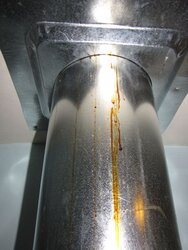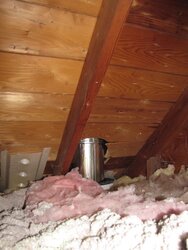We have creosote running down the outside of our double-wall chimney and inside the house! It is oozing out of a seam where two pieces of the pipe meet in the attic and running down along the pipe. See the two pictures below. Click on the second picture of the larger version to see the seam where the creosote is coming from better. Naturally, I have a few questions about this.
Does this mean my chimney pipe was lapped the wrong way when it was installed? The place we purchased the stove from last fall did the installation too. I read online somewhere that pipes should always be lapped so the creosote runs down the chimney, not out.
Is there any particular immediate danger associated with this? The chimney seems quite sturdy and the joint is tight. I don't even understand how the creosote is getting out.
And finally, how should I fix/stop it?
This is our first year burning wood, so I am still learning. I did sweep the chimney mid-way through the season and got only a small amount of hard, black creosote out. There didn't seem to be sticky, brown creosote on the inside of the pipe. But that is what is coming out of the joint. Thanks so much for the advice!
Does this mean my chimney pipe was lapped the wrong way when it was installed? The place we purchased the stove from last fall did the installation too. I read online somewhere that pipes should always be lapped so the creosote runs down the chimney, not out.
Is there any particular immediate danger associated with this? The chimney seems quite sturdy and the joint is tight. I don't even understand how the creosote is getting out.
And finally, how should I fix/stop it?
This is our first year burning wood, so I am still learning. I did sweep the chimney mid-way through the season and got only a small amount of hard, black creosote out. There didn't seem to be sticky, brown creosote on the inside of the pipe. But that is what is coming out of the joint. Thanks so much for the advice!



